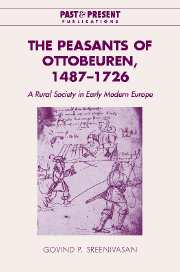Book contents
- Frontmatter
- Contents
- List of figures
- List of maps
- List of tables
- Acknowledgements
- Note on weights, measures, and currencies
- Map 1 Southern Germany, c. 1620
- Map 2 The lands of the monastery of Ottobeuren, 1620
- Introduction
- 1 Right and might (c. 1480–c. 1560)
- 2 The discrete society (c. 1480–c. 1560)
- 3 A crisis of numbers? (c. 1560–c. 1630)
- 4 Integrity and the market (c. 1560–c. 1630)
- 5 Living on borrowed time (c. 1560–c. 1630)
- 6 To empty and to refill (c. 1630–c. 1720)
- Conclusion
- Bibliography
- Index of places
- General index
- Past and Present Publications
Introduction
Published online by Cambridge University Press: 21 July 2009
- Frontmatter
- Contents
- List of figures
- List of maps
- List of tables
- Acknowledgements
- Note on weights, measures, and currencies
- Map 1 Southern Germany, c. 1620
- Map 2 The lands of the monastery of Ottobeuren, 1620
- Introduction
- 1 Right and might (c. 1480–c. 1560)
- 2 The discrete society (c. 1480–c. 1560)
- 3 A crisis of numbers? (c. 1560–c. 1630)
- 4 Integrity and the market (c. 1560–c. 1630)
- 5 Living on borrowed time (c. 1560–c. 1630)
- 6 To empty and to refill (c. 1630–c. 1720)
- Conclusion
- Bibliography
- Index of places
- General index
- Past and Present Publications
Summary
The specter haunting the historiography of early modern Europe is the specter of transition. To be sure, the relatively recent designation of the period c. 1450–c. 1750 as an era unto itself represented multiple intellectual currents, in the first instance a rising interest in social and economic (as opposed to religious and political) questions. At the same time, however, the definition of these centuries as the decisive and traumatic passage from a medieval to a modern world generated a literature pervaded by themes of crisis and revolution (agricultural, commercial, financial, military, scientific, etc.), culminating in a breakthrough variously defined as the beginnings of industrialization, the end of the economic ancien régime, or the transition from feudalism to capitalism. Of course, it was always recognized that economic growth was hardly a universal experience in early modern Europe, but this was accounted for by labeling some parts of the continent (the Mediterranean in general and Spain in particular) as examples of failed transitions and others (northwest Europe in general and England and the Netherlands in particular) as successes. Outcomes were bound to vary, it was felt, in such a wide-ranging struggle between the forces of growth and change and traditional social and economic limits.
Over time, the transitional narrative of early modern social history has lost much of its initial coherence. First and foremost, fifty years of research have forced historians to acknowledge that the performance of the early modern European economy as a whole was sluggish at best.
- Type
- Chapter
- Information
- The Peasants of Ottobeuren, 1487–1726A Rural Society in Early Modern Europe, pp. 1 - 8Publisher: Cambridge University PressPrint publication year: 2004

